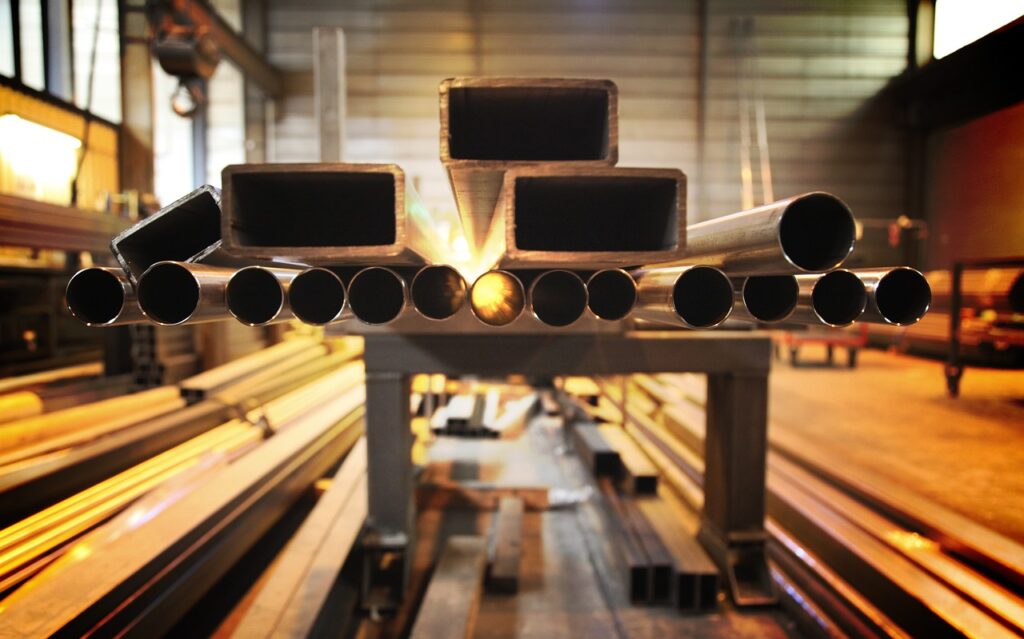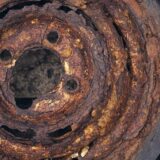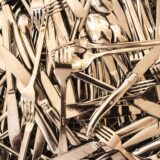
The truth of stainless steel’s superior functionality.
~A common metal that makes the world~
What is Stainless steel? First of all, “steel” is a metal made of Fe (iron) plus C (Carbon) and other metals. Then, “Stainless steel” is a steel containing 10.5% or more Cr (chromium) and 1.2% or less C (carbon). Perhaps, one could simply answer that stainless steel is iron that does not rust or corrode easily.
Actually, there is another answer, and it is this one.
Stainless steel is an attractive metal with excellent functionality and convenience.
Stainless steel is a common metal that is ubiquitous today, but once you know what it is, you will understand why it has become an indispensable material for the world.
Stainless steel has a number of attractive features, but its superior functionality is at the top of the list.
Stainless steel has a high Fe content, which tends to rust easily, yet is resistant to rust, and to say that this functionality is astounding is not an exaggeration.
The reason why stainless steel is called stainless ( rust-free) . Because it does not undergo oxidation.
Oxidation is a phenomenon in which metal elements combine with oxygen in the air and deteriorate, which is rust.
Fe oxidizes easily and still rusts over a long period of time. Cr, which is a metallic element always contained in stainless steel, also oxidizes.
However, when oxidized, Cr has the ability to form a strong film. This strong film has been given the powerful name of “passive film.”
Since stainless steel contains Cr, products made of stainless steel are entirely covered with a passive film, which prevents deterioration.
Remarkably, this passive film is only 13 nanometers thick. Therefore, it does not interfere with the processing of stainless steel.
The passive film is also stable because it has no crystalline structure. In other words, the film is “stuck” to the stainless steel.
The passive film has a self-healing function.
Ordinary coatings lose their protective function if they are broken.
However, the passive film regenerates itself as soon as it is broken. The Cr contained in stainless steel is quickly oxidized to form another passive film.
The passive film on stainless steel occurs spontaneously, covers the stainless steel, and corrects itself spontaneously.
Stainless steel was developed slowly over a period of about 200 years.
200 years ago may seem like a long time ago, but iron has been in use for about 3,000 years, so stainless steel is probably a “young” or at best “mid-career” in the metal world.
Cr, a key component of stainless steel, was discovered in 1797 by a Frenchman named Beauclain. Cr has many colors, including purple, red, and yellow, and yellow color of Cr is also used in the paint of Van Gogh’s “Sunflowers.”
Around 1820, some 20 years after the discovery of Cr, the British researcher Faraday created an alloy containing Cr in steel and investigated its properties.
Subsequently, research on Cr-containing steels progressed in Germany, and in the early 1900s, it was revealed that Cr has corrosion resistance properties. Corrosion resistance refers to the property of being resistant to corrosion.
However, the reason for the corrosion resistance of Cr-containing metals remained unknown for a long time.
Nevertheless, the addition of Cr to steel makes it a useful metal, which is why stainless steel was produced in large quantities and widely used.
Stainless steel was born from the idea of mixing Cr, which was an unknown element, with steel, and spread through the bold challenge of “We don’t know what it is, but it’s a good phenomenon, so let’s mass produce it”.
It was so convenient that it became widespread before the principle was clarified! It is clear that the function of stainless steel has been strongly supported.
Stainless steel has been used for 200 years because it continues to evolve.
To meet a variety of needs, component ratios have been changed and other components have been added, resulting in a wide range of variations.
For example, there are martensitic, ferritic, and austenitic types.
Stainless steel is often referred to by the letter SUS, which means Steel Use Stainless.
Martensitic stainless steels are composed mainly of Cr and C and do not contain nickel (Ni).
While it has the advantage of being hard, it also has the disadvantage of rusting more easily than other stainless steels. For this reason, martensitic stainless steels are used for blades and nozzles, which require hardness but can be replaced in a short period of time.
Martensitic stainless steels include SUS403 and SUS410.
Ferritic type are mainly composed of Cr, with a low C content, and do not contain Ni.
Ferrite alloys are soft and are used for press-formed products.
However, even though they are soft, they are harder than steel, so they are not used for automobile bodies, which require complex shapes. (Steel and aluminum are used for automobile bodies.)
SUS430 is a representative ferritic stainless steel.
Stainless steels containing Ni are austenitic. This is the most used stainless steel in the world.
When Ni is added, it becomes even more rust-resistant and can withstand, for example, seawater. This is why it is used for products that will be used for many years.
Austenitic stainless steel is used for tableware such as spoons and forks, automotive parts, construction materials, chemical industry, food industry, nuclear power generation, and LNG plants.
Austenitic stainless steels include SUS304 and SUS316.
Other types of stainless steel include duplex and precipitation hardening types.
The Japanese standard (JIS) specifies about 60 types of stainless steel, but there are about 200 types in the world.
If stainless steel had not been created, the world would look very different from what it does today.
For example, automobiles, rolling stock, rockets, and nuclear power plants are super advanced products and equipment that were created by mobilizing all of mankind’s knowledge, but without stainless steel, they would not have the performance we have today.
Automobile engines perform better when they are made of materials that remain unchanged at high temperatures, are lightweight, and durable.
Stainless steel meets these requirements, and SUS409L and SUS430J1L are used for engine parts.
The bodies of railroad cars are also made of stainless steel. It is easy to maintain because it does not rust, and its light weight contributes to energy conservation. Furthermore, since railcars have a simpler shape than car bodies, they can be shaped using stainless steel.
Stainless steels used for rolling stock include SUS301L and SUS304.
While absolute safety is required for space development-related products such as rockets, lightness is also important. Heavy rockets are difficult to launch.
For this reason, aluminum alloys are widely used for rocket parts, but aluminum has the disadvantage of being soft. Therefore, aluminum alloys are made by mixing aluminum with other metals, but even so, they are sometimes not strong enough.
In such cases, stainless steel is used, even if it is a little heavier.
Stainless steel used for rocket and aerospace parts is very special and is sometimes called “aerospace grade stainless steel.”
Aerospace grade stainless steels include AMS5659 15-5PH and AMS5643 17-4PH.
The “AMS” at the beginning of the name refers to the Aerospace Material Specifications, an industrial standard that is only given to products that meet strict requirements.
In 1962, Japanese government and other organizations prepared a white paper on atomic energy titled “Development of Materials for Nuclear Reactors,” in which stainless steel is introduced.
Stainless steel is highly evaluated for its “high precision and high tensile strength, as well as its small diameter, thin wall and long length for nuclear reactors.”
Nuclear power plant reactor components must withstand long-term exposure to harsh operating conditions, so the materials used in these components are subjected to rigorous screening.
Stainless steel is a material that has passed this screening.
Even today, many years later, materials made of stainless steel are still used in nuclear power plants.
Stainless steels for nuclear reactors such as 316 for nuclear power plants and 304 for nuclear power plants have been developed.
The stainless steels that make up the world are the treasures of mankind.
However, the “stainless steel legend” is not complete.
Stainless steel is still evolving, and a university is working on the development of a stainless steel that rusts less than gold.
It should continue to be refined in the future!
Enserve finds stainless steel with your desired specifications from anywhere in the world. If you have problems with stable supply, cost reduction, or quality with current stainless steel, please feel contact us now.


